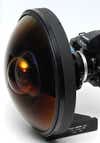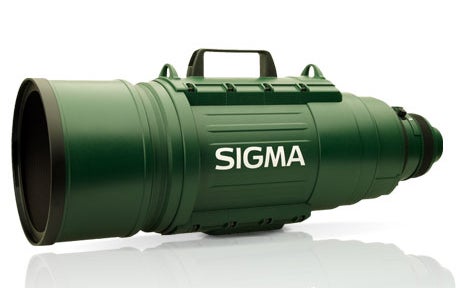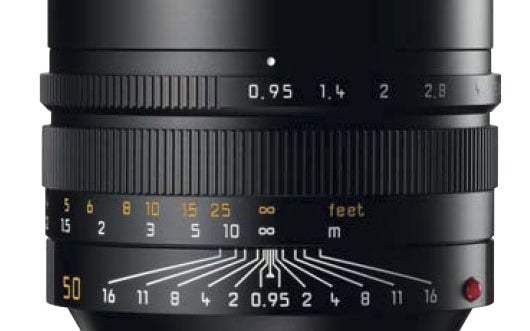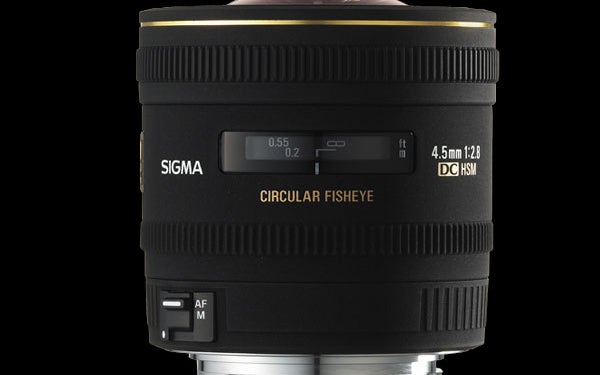9 Unbelievable Camera Lenses That Actually Exist
These rare lenses come with unbelievable specs and spectacular price tags.

We may earn revenue from the products available on this page and participate in affiliate programs. Learn more ›
We’ve pulled together some of the most extreme photographic lenses ever made. Sure, the military or other big corporations may have even crazier glass (NASA, we’re looking at you), but we tried to stick with rangefinder, medium format and SLR compatible optics big-spending photographers could actually buy.

When it comes to lenses without mirrors, the Zeiss Apo Sonnar T* 1700mm, f/4 lens is a front-runner-at least among non-military lenses (we never did apply for Top Secret clearance). Announced and exhibited at the 2006 Photokina, this monster was designed and produced for a “customer with very high demands and a special interest in long distance wildlife photography.” We haven’t been able to find out who the customer was—or whether anyone else has ordered this lens—but the lens features Arabic lettering and an emblem of the State of Qatar, one of the Arab emirates.
Not surprisingly, the lens dwarfs the Hasselblad 203FE 6x6cm medium format camera it was designed to be paired with to such an extent that we didn’t notice that the Hassy was attached in the photo.
The lens utilizes 15 optical elements in 13 groups, with some of the lens blanks weighing more than 55 pounds each, resulting in a gargantuan lens that tips the scales at a monstrous 564 pounds—not the kind of lens you want to move very often, if at all. Even more challenging is operating the lens, a challenge that Zeiss met by developing special servo-controlled aiming and focusing systems, sort of like those used for mega-telescopes. To top it off, the lens is quite beautiful in design.

Although the it didn’t go to the same extreme as Carl Zeiss’ monster lens, it’s still one of the longest—and, at $80,000 (no discounts), one of the most expensive lenses ever made. Originally developed with an FD mount for the 1984 Los Angeles Olympics, five lenses were made available for newspaper, magazine and wire service coverage of the games. After that, the lenses were shipped back to Canon, Inc. in Japan, only to re-appear in the late 1980’s with an EF mount.
Over the years, several new batches of the lens were manufactured but only in small quantities. Essentially the lenses were handmade, which certainly influenced the limited availability and the extreme retail price, but even more importantly, the fact that it took almost a full year to grow fluorite crystals large enough to create the lens elements also kept production numbers low and the price high.
During production, some of the EF 1200mm lenses were purchased by news and sports magazines as well as newspaper and wire services internationally and were used to capture images of Papal elections in Rome, the Olympics, major league baseball, the World Cup, Formula One motorsports, among other important events. Other copies of the lenses went to various governments (no surprise there) and law enforcement agencies. According to Canon, at least a couple of lenses were purchased by private photographers. If you were a member of Canon’s CPS (Canon Professional Services) program, you might have had the chance to borrow one. If not, you’re out of luck. Finding a used version is almost impossible and Canon stopped its extremely limited production several years ago.
Popular Photography
If you’ve been to PMA (the Photo Marketing Association) tradeshow, you might have noticed a military green, humongous lens at Sigma’s booth. Announced and exhibited at the 2007 PMA, the Sigma 200-500mm f/2.8 (which can be pumped up to 400-1000mm using the bundled 2x teleconverter), certainly doesn’t match the telephoto models mentioned above but it definitely sports kickass specs as the largest high speed zoom lens currently on the market. And with an MSRP of $38,000 ($28,900 street) it has the price to match.
The lens weighs about 34.6 pounds (that’s almost $1,000 per pound) and measures 9.3 x 28.6 inches. The combination of telephoto capabilities and an f/2.8 aperture throughout the zoom range up to 500mm makes this a great lens for wildlife, sports and for you stargazers, astrophotography. “Add the generically named “Attachment” and you get a focal range of 400-1000mm and an aperture of f/5.6 at 1000mm—which is still awesomely fast.”
A dedicated Li-ion battery, which is built into the lens barrel, powers the zoom and autofocus. Need to know the focusing and distance numbers? Just check the lens’ built-in LCD. You can drop in 72mm filters at the rear of the lens barrel and there’s even a mechanism to position a circular polarizing lens just the way you want it. You’ll have to provide your own camouflage outfit if you plan on conducting special ops, though.

Using a group of mirrors and a housing that’s almost big enough to use as a coffin, Canon was able to stretch the focal-length on this SLR-specific lens to 5,150mm. Just how long does that make it? The original Canon info sheet claims its best used for photographing obects 18 to 32 miles away. In fact, in order for it tobe able to focus at all, your subject will have to be at least 120 meters (~394 feet) away.
Even with the mirrors to help keep things compact (at least compared to the previously mentioned 1,700mm Zeiss), the total package still weighs 220-pounds without the solid metal stand on which it’s intended to sit. The rest of the measurements are just as impressive, including its 20-inch height, 24-inch width and its massive 75.6-inch length. There’s currently a youtube video of it in action from a few months ago when one went up on ebay and sold for almost $50,000.

The honor of fastest lens goes to Carl Zeiss’ 50mm Planar f/0.70 lens. This specialty lens was used to take the first images of the dark side of the moon, rumor has it that Stanley Kubrick adapted the lens for moviemaking and shot some of the gorgeous candlelit scenes in Barry Lyndon.

Slightly more conventional, at least for photographic purposes, the Canon S-type 50mm lens featured an f/0.95 aperture. Four times faster than the human eye, the lens was the fastest photographic lens in the world at the time. Although an SLR version was never made, it was introduced in 1961 for Canon’s 35mm rangefinder models.
Considered to be one of the “standard” lenses for the Canon 7 rangefinder, the 50mm lens utilized a clip-on mount with a three-lug bayonet system. It was a Gauss type lens (derived from a design patented in the 1800’s by Alvan G. Clark, in which he used two Gaussian telescope lenses opposite each other with a diaphragm between them to correcting aberrations) and consisted of several elements in five groups. Canon discontinued the 50mm, f/0.95 lens—along with its rangefinders—in the early 1970’s. Back then, the retail price for the lens in Japan was 57,000 yen or about $1,150 in today’s dollars.
Popular Photography
In 1975, shortly after Canon discontinued its 50mm, f/0.95 lens, Leica introduced Noctilux-M 50mm f/1 ASPH lens. Following up on that achievement, Leica currently offers the world’s fastest aspherical lens-the Noctilux-M 50mm f/0.95. Dubbed the “King of the Night,” this lens offers an 11% increase in light gathering capacity over its predecessor with only a very minor gain in size.
As its “M” designation implies, the Noctilux is compatible with all Leica M-mount cameras and can even be used with Micro Four Thirds models using a Panasonic DMW-MA2M adapter.
Obviously, this is a great lens for low light and for extremely shallow depth-of-field shots. When we posted this article, the lens was not yet available but once it ships, you’ll be able to pick one up for a cool street price of about $10,500.

Nikon’s 6mm—the world’s first lens with a viewing angle of 220 degrees—gave new meaning to the old adage of having eyes in the back of one’s head. An f/5.6 version was released in 1969, with AI and AIS versions following later.
But it’s the second generation, non-AI f/2.8 model that is the kicker of the group. Not only was it fast but no mirror lock up was required for this retrofocus design, which featured direct reflex viewing and true TTL metering. The 6mm lens produced a circular image and could focus down to 0.25m (0.9 ft). Forget about putting a filter on the front of this bulbous piece of glass; instead, Nikon designed a unique built-in filter system for the lens, so photographers had access to skylight, medium yellow, deep yellow, orange and red filters.
Used for scientific, industrial and special effects photography, the f/2.8 non-AI lens was available only by special order. It cost about $6,000 when released in the mid-1970’s, a bargain by today’s standards.
You can grab a used version of this baby for $34,290 (plus $150 shipping) on eBay-including case, front and rear caps.
Popular Photography
Currently, Sigma offers a couple of interesting extreme wide angle lenses-4.5mm f/2.8 EX DC HSM circular fisheye lens and the AF 8-16mm f/4.5-5.6 DC HSM lens, both of which are readily available to photographers right now.
The former offers a close-up focusing distance of 5.3 inches and, like Nikon’s 6mm lens, is used for scientific applications as well as more creative photography. It’s a lot smaller, lighter and less expensive too; the MSRP is $1,500 but you can probably pick it up for less.
Sigma’s 8-16mm lens (designed for APS-C sensors, with an effective focal range of about 12-24mm), is a rectilinear wide angle lens with a twist. Our resident lens guru, Julia Silber, is currently testing Sigma’s 8-16mm lens for PopPhoto, and reports that you can see the outline of the rectangle in the lens but you can add a special ring to the front of the lens to get a circular (vignetting) effect. (Actually, the ring is included so you can attach a cap over the lens’ “bulb.”) Like its sibling, the 8-16mm is tiny and inexpensive compared to the Nikon 6mm lens and has an MSRP of $1,100.


